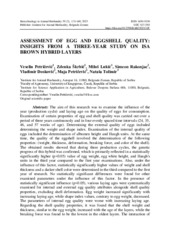Приказ основних података о документу
Assessment of egg and eggshell quality: Insights from a three-year study on Isa Brown hybrid layers
| dc.creator | Petričević, Veselin | |
| dc.creator | Škrbić, Zdenka | |
| dc.creator | Lukić, Miloš | |
| dc.creator | Rakonjac, Simeon | |
| dc.creator | Dosković, Vladimir | |
| dc.creator | Petričević, Maja | |
| dc.creator | Tolimir, Nataša | |
| dc.date.accessioned | 2023-12-22T08:58:27Z | |
| dc.date.available | 2023-12-22T08:58:27Z | |
| dc.date.issued | 2023-12-18 | |
| dc.identifier.issn | 1450-9156 | |
| dc.identifier.uri | http://r.istocar.bg.ac.rs/handle/123456789/972 | |
| dc.description.abstract | The aim of this research was to examine the influence of the year (production cycle) and laying age on the quality of eggs for consumption. Examination of certain properties of egg and shell quality was carried out over a period of three years continuously and in four evenly spaced time intervals (24, 35, 46, and 57 weeks of age). Determining the external quality of eggs included determining the weight and shape index. Examination of the internal quality of eggs included the determination of albumen height and Haugh units. At the same time, the quality of the eggshell involved the determination of the following properties: (weight, thickness, deformation, breaking force, and color of the shell). The obtained results showed that during three production cycles, the genetic progress of this hybrid was confirmed, which is primarily reflected in a statistically significantly higher (p<0.05) value of egg weight, egg white height, and Haugh's units in the third year compared to the first year examinations. Also, under the influence of this factor, statistically significantly higher values of weight and shell thickness and a darker shell color were determined in the third compared to the first year of research. No statistically significant differences were found for other examined parameters under the influence of this factor. In the presence of statistically significant influence (p<0.05), various laying ages were systematically examined for internal and external egg quality attributes alongside shell quality properties, excluding shell deformation. Egg weight increased significantly with increasing laying age, while shape index values, contrary to egg weight, decreased. The parameters of internal egg quality were worse with increasing laying age. Regarding the shell quality properties, it was found that the shell weight and thickness, similar to the egg weight, increased with the age of the layers, while the breaking force was found to be the lowest in the oldest layers. The interaction of both tested factors did not cause a statistically significant effect on tested egg quality traits. | sr |
| dc.language.iso | en | sr |
| dc.publisher | Institute for Animal Husbandry, Belgrade-Zemun | sr |
| dc.relation | info:eu-repo/grantAgreement/MESTD/inst-2020/200022/RS// | sr |
| dc.relation | info:eu-repo/grantAgreement/MESTD/inst-2020/200088/RS// | sr |
| dc.relation | info:eu-repo/grantAgreement/MESTD/inst-2020/200045/RS// | sr |
| dc.rights | openAccess | sr |
| dc.rights.uri | https://creativecommons.org/licenses/by/4.0/ | |
| dc.source | Biotechnology in Animal Husbandry | sr |
| dc.subject | egg quality | sr |
| dc.subject | laying age | sr |
| dc.subject | shell quality | sr |
| dc.subject | Isa Brown | sr |
| dc.title | Assessment of egg and eggshell quality: Insights from a three-year study on Isa Brown hybrid layers | sr |
| dc.type | article | sr |
| dc.rights.license | BY | sr |
| dc.citation.volume | 39 | |
| dc.citation.issue | 2 | |
| dc.citation.spage | 131 | |
| dc.citation.epage | 140 | |
| dc.identifier.doi | 10.2298/BAH2302131P | |
| dc.identifier.fulltext | http://r.istocar.bg.ac.rs/bitstream/id/4570/bitstream_4570.pdf | |
| dc.type.version | publishedVersion | sr |


